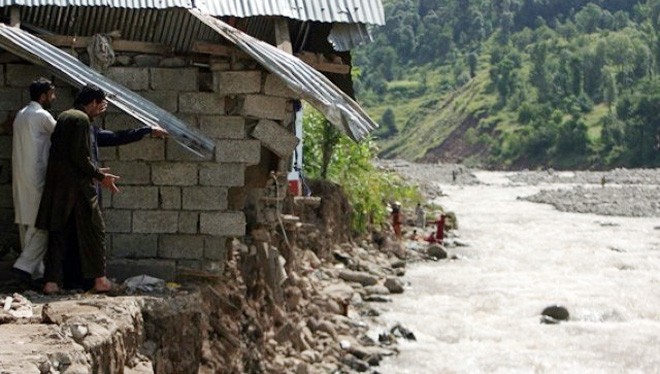
The catastrophe in AJK once again underlines the need to conceive a cross-LOC joint mechanism

Disaster knows no boundaries. Like other parts of Pakistan, Azad Jammu and Kashmir (AJK) has been through unprecedented devastation by the recent flood.
River Jhelum witnessed the highest ever rise in water level, at some points it reached 25 metres. It runs through Srinagar city, flows through the peaks of AJK and finally drains into the plains of Punjab.
It is reported the Indian administered Jammu and Kashmir faced the worst flood in the last six decades.
Several districts and major towns of AJK were cut off for many days. The flood has hit districts Haveli and Sudhnati hard. According to Muhammad Akram Sohail, Secretary to State Disaster Management Authority (SDMA) death toll is 64 so far. Nearly 27,700 people and 120 villages have been affected.
Initial estimate shows that flood damages would be more than Rs7 billion. Roads, schools and even small hydel-power projects and bridges were razed to the ground. The only road connecting Muzaffarabad to Srinagar came under water at certain places, disrupting traffic cross the LoC.
Azad Kashmir witnessed a shattering earthquake in 2005 wherein nearly 47,000 people died. Life for inhabitants of Muzaffarabad and Bagh has only recently returned to normal.
A small number of people are still struggling to cope with the loss separation of their loved ones. School buildings are still incomplete and children have to study in open sky in harsh weather.
Nine years on, over 200,000 children are studying either in temporary shelters or tents. Large funds provided by the international donor agencies were either misused or diverted to other projects. It has created huge trust deficit between citizens and state.
Also read: When rain breaks loose
Prime Minister Nawaz Sharif rushed to Rawalakot to show solidarity with people of Azad Kashmir.
To the utter surprise of flood-affected people, authorities could not resist to exhibit pompous VIP culture even during the peak of disaster. Locals bluntly told the prime minister that little help came from administration in their trying time. Common people complained that when they were battling for survival, authorities were nowhere.
It was brought to Prime Minister Nawaz Sharif’s notice that not only Prime Minister Chaudhary Abdul Majeed but also his cabinet colleagues spend most of their time in Islamabad or their respective constituencies.
Following the footsteps of elected leadership, bureaucrats have also shifted their families to Islamabad/Rawalpindi where, unlike AJK, better educational opportunities and healthcare is available. The capital of AJK-Muzaffarabad, remains a deserted city all the year round. In the absence of elected leadership, administration also remains inaccessible to a great extent.
State Disaster Management Authority (SDMA) was established in 1996 to handle natural calamities but till now it neither has financial nor human resources to encounter these enormous tasks.
It is a known fact that Kashmir across the Line of Control and Muzaffarabad, Bagh and Rawalakot are one of the most seismic prone regions. Besides, the region frequently witnesses floods, landslides, cloudbursts and avalanches -- but there is little advance preparation to protect citizens from these challenges.
Pakistan Army is at the forefront to provide relief and rescue to the people trapped in the flood and landslides.
Some of the Islamic charity organisations such as Falah-e-Insaniyat Foundation (FIF) subsidiary of the Jamat-ud-Dawa Pakistan and Al-Khidmat Foundation, the charity wing of Jamaat-e-Islami are actively involved in the rescue and rehabilitation operations.
The post-2005 earthquake relief activities paved the way for the national and international non-governmental organisations to make inroads in AJK, which was previously largely a no-go area for the international donors. Fifty two international non-governmental organisations (INGOs) spent a large amount of resources and time in the rehabilitation and reconstruction of AJK.
A number of local organisations came into being and partnered with the international organisations in the sphere of service delivery, relief and reconstruction.
However, bureaucracy quickly made it almost impossible for international organisations to work in the area. Cumbersome procedures were put in place to discourage INGOs to visit AJK let alone supporting the local community organisations.
All foreigner visitors have to obtain no objection certificate (NOC) from the federal Ministry of Interior which requires intelligence clearance. Even diplomats stationed in Islamabad are not able to get NOC on short notice.
Eventually, AJK got off from the donor agencies priority list. In 2010, flood donor agencies provided huge financial and infrastructural support to people of Khyber Pakhtunkhwa (KPK), Punjab and Sindh but AJK largely remained deprived due to undue travel restrictions.
This natural calamity on both sides of the Line of Control once again brought India and Pakistan close to each other when their relations were at the lowest ebb.
Prime Minister Narendra Modi offered Pakistan help for the rain-affected people of AJK. Prime Minister Nawaz Sharif while reciprocating the offer said that his country was ready to help the people affected by rains in Indian held Kashmir in "whatever manner was required".
Though these offers were symbolic, they have huge value in the context of the upcoming United Nations General Assembly annual session this month where chances of both prime ministers meeting was quite blurry -- due to the recent bickering between Islamabad and New Delhi.
It is common perception in AJK that had authorities on the AJK side of the LoC informed before opening the floodgates in Indian administered J&K, it might have lessened the damage.
The current calamity once again underlines the urgent need to conceive a cross-LoC joint mechanism to mitigate the suffering of people in case of natural calamities.